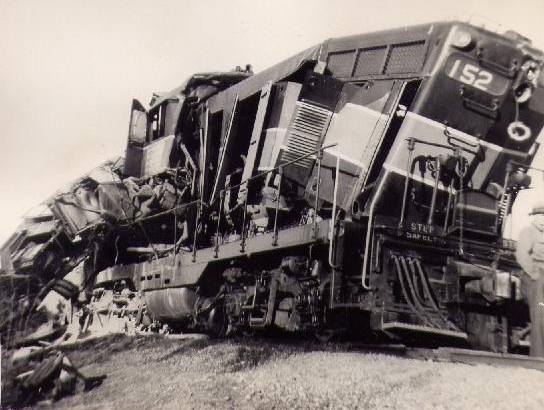MV Wreck Bokoshe,OK 2/1/58
All photos by H.E.Huber
On Feb. 1, 1958, westbound train 41 with MV #152 collided head-on with eastbound train 42 with MV #153 on the curve at Bokoshe, OK. Four crew members died and seven were injured. |
 |
| A fatal accident occured on the Midland Valley at Bokoshe, Oklahoma on 1 Feb 1958. The Midland Valley ran from Wichita to the vicinity of Fort Smith, and was operated in three subdivisions, Western, Middle and Eastern. The Eastern Subdivision ran from Muskogee to Fort Smith, with entry to Fort Smith over 15.4 miles of joint track with the Frisco. This was a single track, operated by time table and train order, with day offices at Porum, Stigler, Panama and Rock Island. The office at Muskogee was open continuously, since the dispatcher was located here at the headquarters of the company. Trains originated at Shopton, 1.1 miles east of Muskogee, but called for orders at Muskogee. The speed limit was 30 mph. |
| Eastward trains were superior to westward trains of the same class on the Eastern Subdivision. The only scheduled trains were No. 42, eastward, and No. 41, westward, both local freight trains, scheduled to leave their initial stations in the morning and complete their 100-mile runs a little after noon. 1 February 1958 was a Saturday, so normally there would be no open offices, except Panama for a couple of hours around noon. However, the dispatcher had notified the operator at Stigler to go on duty at 10 am to handle some paperwork there. |
| No. 41 had departed Rock Island at 9.35 am, 2 hours and 20 minutes late, and arrived Panama at 9.55 am. The time table meet with No. 42 was at Stigler, but No. 41 could not leave Panama because it could not clear at Keota in time. No. 42 left Shopton at 8.30 am, 30 minutes late, with work to do at Warner, Briartown and Keota. Stigler was the next station west of Keota, and this morning the dispatcher had an operator there, so he decided to restrict No. 42 at Keota so that No. 41 could leave Panama. Order No. 27 said: "No 41 Eng 152 meet No 42 Eng 153 at Keota No 41 hold main track at Keota." The order was made complete at 10.34 am at Panama and No. 41 left at 10.35. |
| Of course, before this occurred, the dispatcher asked the operator at Stigler if No. 42 had arrived. The operator said he had not seen it. The operator had gone on duty at 10 am, so all he could say is that it had not passed in the last half hour. In fact, No. 42 had passed Briartown (the station next west of Stigler) at 9.40 am, Stigler at 9.55 am, and arrived in Keota at 10.20 am. After doing its work, it left at 10.30 am. No. 42 was almost to Panama before No. 41 left there! The lack of open offices meant that the dispatcher had no idea of what progress the trains were making, and he made an incorrect assumption. |
| The Fort Smith and Van Buren crossed the Midland Valley at Bokoshe, which had no siding, only a station sign. The crossing was gated against the FS&VB, so MV trains could cross at restricted speed without stopping. No 41 and No 42 collided on a curve 1213' west of the station sign, No. 41 moving at 30 mph and No. 42 at 25 mph. No. 41 had 4 cars and a caboose, No. 42 12 cars and a caboose. The collision split the diesel tanks of both locomotives, and ruptured a tank car loaded with gasoline. The fire destroyed both locomotives and several cars of their trains. The engineman and front brakeman of No. 42, and the fireman of No. 41 were killed. |
| Rule 36 of the company's rules for dispatchers stated that a train must not be restricted on an operator's statement when the operator has been absent from the office. It is a rather fundamental principle that a train cannot be restricted at a station that it has passed, and this accident illustrates the danger very well. |
| This appears to be the only serious accident in the history of the Midland Valley system, which consisted of the MV, the Kansas, Oklahoma and Gulf, and the Oklahoma City-Ada-Atoka. The MV also had an encounter with the CRI&P at Midland Tower, KS. The OC-A-A had a collision between a passenger train and a freight at Konawa in 1927, but no passengers were killed, and a work train difficulty at Ada in 1929. The Missouri, Oklahoma and Gulf, a predecessor of the KO&G, had a freight derailment on unballasted track in 1916, and the KO&G a head-end collision of freights at Kenefick, OK in 1931. |
H.E.Huber Photo |
H.E.Huber Photo |